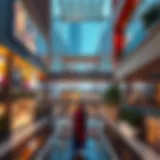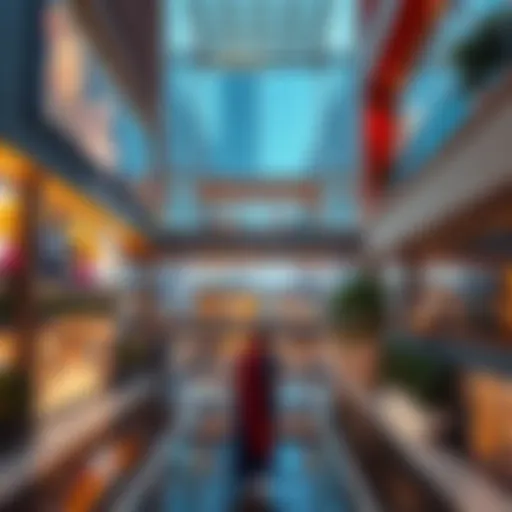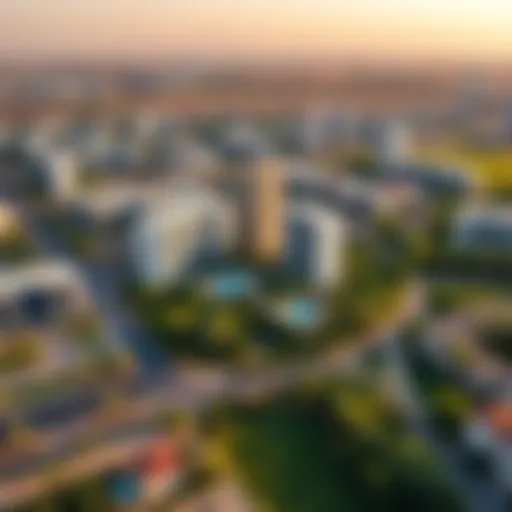Exploring Partition Rooms in Dubai: Trends and Design
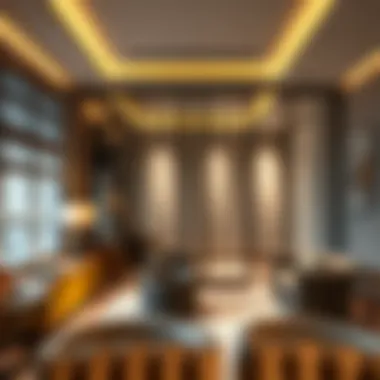
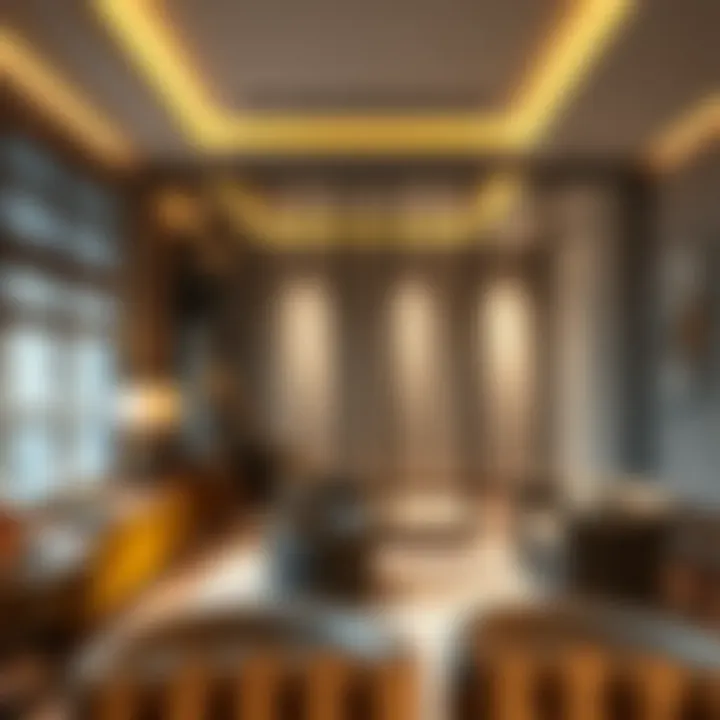
Intro
Dubai’s real estate landscape is an interesting blend of tradition and modernity. With its bustling city life, partition rooms have carved a niche for themselves as practical living solutions. Partition rooms are not just about splitting spaces; they offer flexibility for homeowners and renters while maximizing the utility of often limited square footage.
As many residents seek affordable and functional housing options, understanding the nuances of partitioned living spaces becomes crucial. This article will explore the design elements of partition rooms, their functionality, and how they resonate with current market trends. From first-time buyers trying to navigate their way through, to seasoned investors assessing the value of properties, everyone will find something of benefit.
Here, we cover:
- The current market scenario affecting prices and demands for partitioned spaces.
- Future market predictions that may sway investment options.
- Essential tips for prospective buyers and renters in this dynamic landscape.
This guide aims to equip you with deep insights, ensuring you can maneuver through the complexities surrounding partitioned living in Dubai.
Market Trends
Current Real Estate Prices
The real estate market in Dubai is as volatile as the weather is comforting. Currently, prices for partition rooms reflect a balanced relationship between supply and demand. Many new developments cater to the rising need for affordable living spaces, resulting in some competitive pricing. Analyzing reports from sources like Property Finder, it appears that on average, a partition room can range from AED 40,000 to AED 70,000. Factors contributing to these prices include location, amenities, and the overall aesthetic appeal of the buildings.
"Understanding the current pricing dynamics in partitioned spaces is crucial for assets' potential value appreciation."
Future Market Predictions
Looking ahead, designers and architects foresee partition rooms gaining more traction. With population growth and the influx of expatriates, it’s likely that the demand will only increase. Analysts suggest that as companies continue to embrace remote working, more people will be looking for ways to make the most of smaller living spaces.
- Potential increases in demand:
- More developments in commercial areas may influence residential capabilities.
- Economic stability will play a significant role in boosting investor confidence.
- Innovations in interior design will enhance the perception of partitioned rooms.
It is very possible that by 2025, prices could increase by up to 15%. Investors looking for opportunities will find this sector increasingly favorable as societal norms shift toward more adaptable living arrangements.
Buying and Renting Guide
Essential Tips for First-Time Buyers
- Understand your needs. Consider whether you need the partitions for privacy, workspace, or family arrangements.
- Research the area thoroughly. The neighborhood's vibe can greatly affect your lifestyle.
- Always check the quality of materials used in partition installations. Not all partitions are created equally. Remember, durability matters.
- Consider the resale value. Look into potential future demand in that area for partitioned homes.
Navigating Rental Agreements
For those looking to rent, understanding your rights and obligations in a rental agreement is essential. Here are a few pointers:
- Typically, you should expect a year-long commitment. Make sure to clarify terms around security deposits and maintenance responsibilities.
- It’s vital to understand the clauses relating to partition spaces, especially if you plan on customizing or enhancing them.
- Read the fine print regarding utilities and shared amenities—knowing these can prevent unexpected costs.
Investors, homeowners, renters, and real estate professionals all have a stake in how partitioned living is evolving in Dubai. Changes in design preferences, market trends, and economic indicators will continually shape this ever-growing segment of the real estate market. Keep your ear to the ground for trends that will impact property values and rental yields.
Intro to Partition Rooms in Dubai
In the ever-evolving landscape of Dubai's real estate market, understanding partition rooms has become increasingly critical. With a booming population and diverse lifestyle needs, partitioned spaces offer a unique solution for both maximizing living areas and optimizing functionality. The trend of partitioning room spaces taps into the heart of modern living, catering to families, singles, and professionals who require adaptable environments. This article aims to unpack this concept thoroughly, shedding light on its design implications, functionality, and contemporary market trends.
Definition and Concept
Partition rooms, simply put, are spaces that have been divided into separate areas using various forms of physical partitions. These could range from traditional walls to modern, flexible solutions like sliding panels or even curtains. In Dubai, where space can be at a premium, the ability to tailor an environment according to personal or commercial requirements is invaluable.
When we talk about partitioning in Dubai, we're looking at how best to utilize every inch of a space efficiently. For example, an open-plan apartment can be segmented to create distinct living, dining, and even work areas, catering to both personal needs and enhancing privacy. This flexibility allows individuals to adapt their spaces to occasion and function, ensuring that whether it’s a bustling family gathering or a quiet evening alone, the environment can shift seamlessly.
Historical Context
To truly grasp the significance of partition rooms in Dubai, it is essential to delve into their historical context. Traditionally, architectural designs in the region favored open spaces. This reflects the cultural values of hospitality and community, where large communal areas were commonplace. However, as Dubai transformed into a global hub, the influx of expatriates brought about diverse preferences and expectations for living arrangements.
Changes began to emerge in the early 2000s, as developers sought to respond to the growing demand for customizable living environments. The architectural landscape shifted, embracing partition walls and modular designs aimed at fostering flexibility. Today, this evolution reflects not just a trend, but a transformational shift in how residents view their living spaces.
As partition rooms gained popularity, they have been embraced across a broad spectrum, from luxurious villas with high-end finishes to functional studios in bustling neighborhoods. This evolution mirrors the broader changes in Dubai’s society, where practicality meets contemporary design.
"In Dubai, partition rooms are more than just a layout choice; they symbolize the blend of functionality and individualism in urban living."
Understanding the background of partition spaces helps stakeholders—from investors to homeowners—recognize the growing demand for nuanced, adaptable living arrangements. As the city's demographics continue to evolve, so do the expectations surrounding residential compositions.
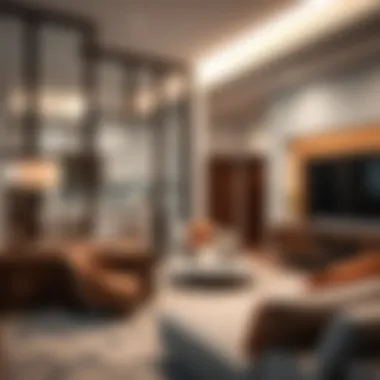
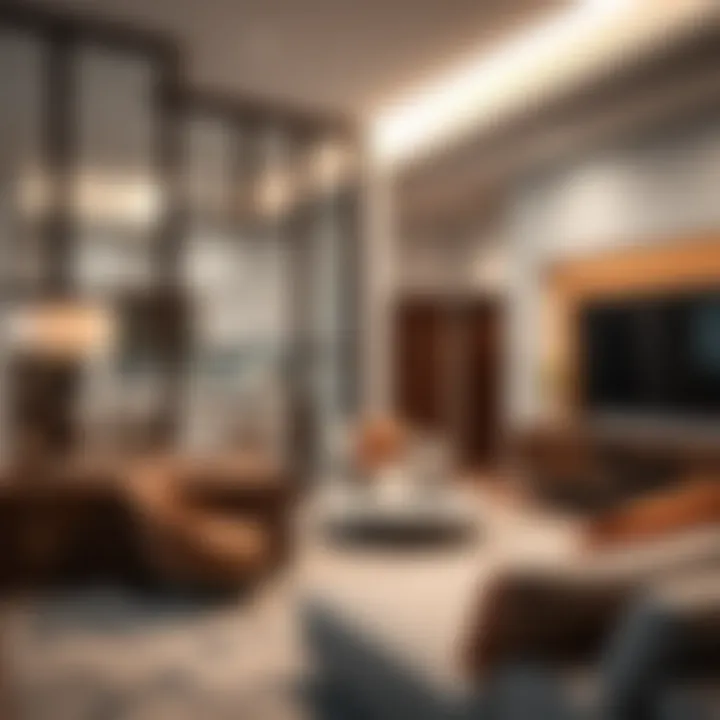
The Relevance of Partition Rooms
Partition rooms are becoming increasingly significant in Dubai's ever-evolving real estate landscape. Their relevance lies not only in their practical applications but also in how they reflect current societal needs and preferences. With the increasing cost of property and premium on space, partition rooms have become a viable solution for individuals seeking more functionality from limited square footage.
Space Optimization
In an urban environment like Dubai, optimizing space is no longer a luxury but a necessity. With various property sizes available and a constant influx of residents, partitioning has emerged as a clever strategy to maximize the utility of available square footage.
Partitioning a room transforms a single area into multiple functional spaces, catering to different needs. For example:
- Home Offices: With more people working remotely, converting part of a living room or a bedroom into a workspace has become essential. Features like movable walls or flexible furniture allow individuals to create a productive environment without losing the comfort of home.
- Recreational Areas: A once open plan design can host children’s play areas or entertainment sections using partitions, effectively segmenting personal spaces while maintaining a cohesive aesthetic.
- Rental Opportunities: For investors, partition rooms enable the creation of rentable units within larger apartments, increasing overall revenue potential. In a city where transient populations are common, grappling with housing shortages can be addressed with strategic partitioning.
As Dubai's skyline changes, the usage of partition rooms is a testament to how innovation thrives amid constraints.
Lifestyle Trends
Partition rooms have also become a reflection of shifting lifestyle trends. People these days value flexibility—something that traditional layouts may not provide. The trend towards minimalism has encouraged individuals to adopt smaller living spaces while focusing on functionality.
Consider these lifestyle shifts:
- Multi-Generational Living: Families often merge households. Partitioned spaces allow distinct areas for families, ensuring privacy without sacrificing togetherness. This aligns with cultural values in Dubai, where familial ties are strong.
- Sustainability: As environmental consciousness grows, many Dubai residents are seeking sustainable living options. Smaller, well-designed spaces can utilize fewer resources, blending eco-friendliness with modern design.
- Technology Integration: Smart home devices and furniture that adapt to partitions allow seamlessly transitioning between activities, such as working, relaxing, or entertaining guests. This tech-savvy approach resonates with a younger, more progressive demographic.
The relevance of partition rooms in Dubai extends far beyond just a design choice. They embody the adaptability of lifestyles while addressing practical constraints that many face living in a bustling metropolis.
Design Considerations
Design considerations play a pivotal role in shaping partition rooms in Dubai, reflecting the dynamic interplay between aesthetics and functionality. As urban living continues to evolve, the demand for versatile spaces becomes more pronounced. Understanding how design elements can enhance or detract from the usability of a room can drastically affect both the livability and market value of a property.
Materials and Construction
When it comes to partition rooms, the choice of materials is fundamental. From gypsum boards to glass panels, each material offers distinct advantages and disadvantages.
Common materials include:
- Gypsum drywall: Lightweight and easy to install, it's often used for economical partitions.
- Glass: A modern choice that enhances natural light while creating an open feel, though it can be pricier and less private.
- Wood: Provides warmth and texture, but requires maintenance over time.
- Metal: Offers industrial aesthetics and durability, suitable for both commercial and residential applications.
The construction method also demands careful consideration. A well-planned layout can optimize the use of available space, ensuring that partitions both define areas and facilitate smooth movement. Ultimately, the materials and construction methods employed can significantly impact the efficacy, comfort, and value of partitioned spaces.
Aesthetic Choices
Designing a partition room involves not only practical decisions but also aesthetic ones. Striking a balance between form and function is crucial. When choosing colors, textures, and layouts, consider how these choices affect the overall ambiance of a room.
- Color palettes: Light colors can make spaces appear larger, while darker hues can create a cozier feeling.
- Textures: Incorporating various textures can add depth and interest, making a space visually appealing. For example, a glass partition can be complemented with rich fabrics in the surrounding area.
Key aesthetic choices include:
- Modern sleek designs that suit urban lifestyles
- Traditional styles that reflect cultural heritage
- Minimalistic approaches that focus on simplicity
Design engages with the emotions of inhabitants and visitors alike. A thoughtfully designed partition can evoke a sense of tranquility or energy, depending on its intended use and placement.
Functionality versus Style
In the world of interior design, functionality always walks hand-in-hand with style. A beautifully designed partition is of little utility if it compromises space efficiency or limits other crucial functionalities.
Take, for instance, a sliding wall system. While they provide sleek, modern aesthetics, they must also allow for seamless transitions between spaces.
Consider this:
- Multi-use spaces: Partition rooms should facilitate varied functions—living, working, and entertaining—without causing chaos.
- Storage considerations: Hidden storage solutions within partitions can help keep clutter at bay while enhancing the elegance of a room.
Maintaining equilibrium between functionality and style often serves as the make-or-break factor in partition design.
Regulations and Compliance
Navigating the world of partition rooms in Dubai isn't just about understanding design or functionality; it's equally crucial to grasp the regulatory landscape that governs such installations. Compliance with local regulations isn’t just a bureaucratic hurdle; it ensures safety, sustainability, and enhances the overall value of the property. Failing to adhere to these guidelines can result in hefty fines or, worse, forceful removal of unauthorized constructions. In a city as dynamic as Dubai, where architectural innovation and strict adherence to regulations co-exist, understanding these elements can save investors and homeowners both time and money.
Local Building Codes
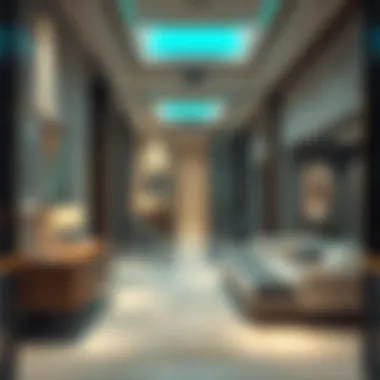
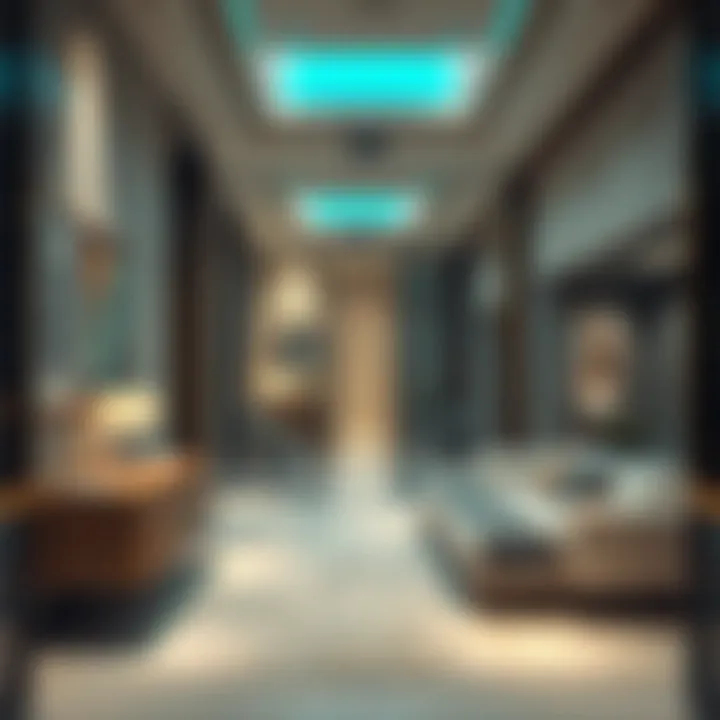
Local building codes are the backbone of any construction project in Dubai. These codes dictate the standards for construction practices to ensure safety and structural integrity. For partition rooms, several key regulations come into play:
- Height Limitations: Depending on the type of partition, there might be restrictions on how high the walls can go. For example, some partitions can only be a certain height to ensure they don’t impede fire safety protocols.
- Material Standards: There are strict guidelines on the materials that can be used, especially regarding fire resistance, particularly in high-rise buildings. It’s essential that partition materials conform to these specifications to avoid liability issues.
- Emergency Access: Regulations often require that partition rooms do not obstruct exits or corridors, particularly in commercial properties. In the event of an emergency, easy access is paramount.
It’s advisable for builders and homeowners to consult with local authority guidelines or professionals familiar with Dubai’s regulations before commencing any work. This diligence can prevent issues related to non-compliance down the line.
Impact on Property Value
The way partition rooms are executed can significantly influence property value. Here are a few aspects to consider regarding impact:
- Market Appeal: Properties that adhere to local regulations tend to attract more buyers. Potential owners are often wary of homes that feature unauthorized additions as these can lead to legal complications or renovation costs.
- Rental Income Potential: Compliant partition rooms can lead to better rental yield. In a city where space is at a premium, well-designed, code-compliant rooms can cater to demand, allowing owners to charge higher rents.
- Long-Term Investment: Properties that are built by the book not only appreciate more reliably over time but also exhibit lower risks for investors. Buyers in the Dubai real estate market are often looking for grounds in which they can trust that their investment will not only hold but grow in value.
Market Trends
In the bustling landscape of Dubai's real estate, understanding market trends is pivotal. The significance of partition rooms stretches beyond mere aesthetics—these spaces create viable solutions in a city where every square foot counts. As the demand for functional living arrangements continues to rise, investors, homeowners, and real estate professionals alike would benefit from analyzing the shifting preferences of potential buyers.
Recognizing current trends allows stakeholders to position themselves strategically in a competitive market. By grasping what is in vogue—be it space-saving designs or multifunctional living areas—investors can maximize their rental yields and property values significantly.
Current Demand Analysis
Over the last few years, the demand for partition rooms has surged, especially among young professionals and families. Many individuals are seeking more flexible living situations, driven largely by an influx of expatriates and a growing trend towards remote work. Data shows that properties with partitioned areas are often snapped up quicker than traditional layouts, representing a notable shift in buyer preferences.
- Affordability Concerns: With rising costs in Dubai, many are looking for ways to stretch their budgets. Partition rooms allow for a more affordable living arrangement—co-living setups are gaining popularity, appealing to those looking to share space without sacrificing privacy.
- Increased Focus on Functionality: Homeowners are increasingly prioritizing functionality over size. A small apartment that uses partitions efficiently can accommodate various activities, meeting the needs of different occupants under one roof.
"As living spaces shrink, the way we partition these areas can make all the difference in both comfort and utility," says a recent local market report.
Emerging Patterns
Several emerging patterns illustrate how partition rooms are evolving in response to current consumer demands:
- Sustainability: Environmentally friendly materials are taking center stage. Many designers are choosing to incorporate sustainable and recycled materials in partition construction, aligning with the eco-conscious mentality among residents.
- Smart Technology: The integration of smart home technology is another trend. Automated partitions that can be adjusted based on user needs—such as changing from open space to private rooms—are becoming more common. This adaptability aligns perfectly with the fast-paced and ever-changing lifestyle of Dubai residents.
- Aesthetic Appeal: Enhancements in aesthetics are also notable. Modern partition designs are not just functional, they are also visually captivating, incorporating elements like glass and artistic wall designs that appeal to a discerning audience.
Clearly, the market for partition rooms in Dubai is not just experiencing growth but is also using innovation to redefine living spaces. Investors must keep a keen eye on these trends, as they provide opportunities for enhancing property value and catering to contemporary demands.
Investment Perspectives
When it comes to assessing the potential of partition rooms in Dubai, one cannot overlook the financial implications. This section delves into the investment landscape surrounding these unique living arrangements, focusing largely on how they affect financial returns for owners and investors alike.
The concept of partition rooms is gaining traction for valid reasons. Space optimization strategies meet modern lifestyle needs, but beyond aesthetics and practicality, these rooms can significantly influence investment decisions. Understanding both rental yields and resale value considerations offers a clearer picture for stakeholders navigating the ever-evolving property landscape in Dubai.
Rental Yields
Rental yields derived from partition rooms generally prove to be attractive, especially in the bustling Dubai real estate market. The average return on investment (ROI) for partitioned apartments often surpasses that of traditional rentals due to the flexibility these designs offer. If one were to take a closer look, several factors contribute to this.
- Higher Occupancy Rates: Partition rooms often appeal to a broader audience—students, young professionals, or expatriates—leading to shorter vacancies and that translates into consistent cash flow.
- Shared Resources: Living arrangements with partition features can benefit from shared amenities, thereby lowering the operational costs for tenants while maintaining rental prices. A lower cost of living can attract more tenants, keeping properties rented.
- Dynamic Rent Setting: Given that the market is continually changing, landlords have an advantage when setting rental prices. The demand for such micro-living solutions in Dubai's urban centers enables landlords to adapt their pricing models, leading to higher overall yields.
"Investors who understand the shifting tides of demand for flexible living arrangements can truly maximize on potential returns."
Resale Value Considerations
When it comes to resale, partition rooms offer a different dimension to property value. Investors and sellers must account for several key considerations:
- Market Demand Fluctuations: As more people embrace modern or cooperative living styles, properties with partition rooms can see increased interest. Thus, these homes may retain their value better than traditional layouts during economic downturns.
- Design Quality Matters: Well-designed partition room setups increase the overall attractiveness of a property. Quality materials and functional layouts will influence prospective buyers’ decisions significantly, creating a premium for resale.
- Future-Proofing Properties: Sustainability becomes a factor in today's real estate market. Buyers are increasingly leaning toward properties that align with ecological standards. Partitioned homes often engage in energy-efficient designs, giving them a competitive edge in resale.
Case Studies
Understanding the practical implications of partition rooms in Dubai requires a close look at real-world examples. Case studies serve as a valuable lens through which we can view how these living arrangements have been implemented, offering insights that may not be immediately obvious from a theoretical standpoint. They illustrate the diverse applications of partition rooms, highlight innovative solutions to challenges, and ultimately pave the way for future developments in this ever-evolving landscape.
Successful Implementations
In various neighborhoods throughout Dubai, several successful implementations of partition rooms have become notable. One such example can be seen in the Jumeirah district. Here, a residential building underwent a strategic redesign to create partitioned units tailored for young professionals.
- Utilization of Space: Rather than conforming to traditional layouts, the developers opted for modular partitioning strategies. This flexibility allowed residents to customize their living space according to personal preferences and lifestyle needs.
- Community-Oriented Design: They integrated community spaces that encouraged interaction while maintaining the privacy of individual units. This balance attracted many renters seeking both autonomy and social opportunities, making the building one of the most sought-after within its price range.
Another remarkable case is the residential complex in Dubai Marina, where partition rooms were designed to cater specifically to expatriate families.
- Cultural Sensitivity: The design took into account the diverse backgrounds of its residents. Various unit styles, from minimalist Scandinavian to cozy Mediterranean inspirations, provided options that resonated with different tenants.
- Function meets Aesthetic: Moreover, the use of eco-friendly materials and smart technologies enhanced the living experience, as energy-efficient systems reduced costs while also appealing to environmentally conscious renters.
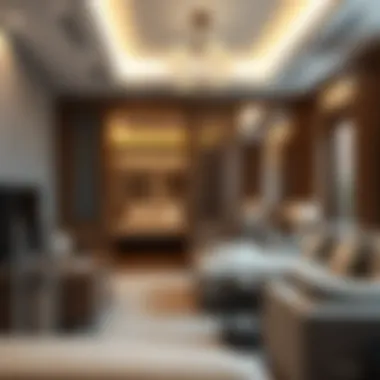
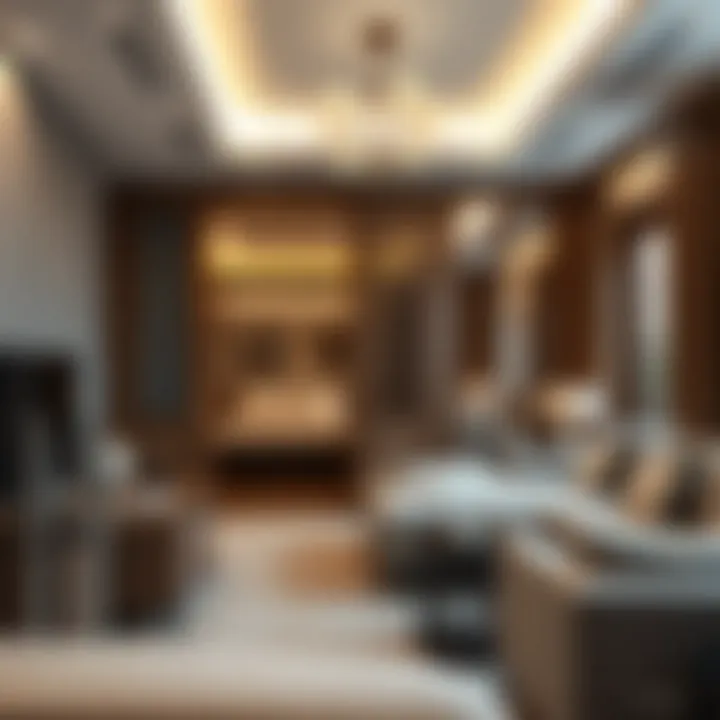
These projects exemplify how thoughtful design and functionality can intersect, resulting in successful implementations that respond to the demands of the local market.
Lessons Learned
Every successful case carries with it a set of lessons that shape future endeavors in the field of partition rooms. From these examples in Dubai, several key takeaways emerge:
- Flexibility is Key: The adaptability of partition spaces caters to a wide range of tenants' needs, making it crucial to maintain flexibility in design.
- Incorporating Community Aspects: Successful projects often integrate communal areas where residents can connect, promoting a sense of belonging and enhancing overall living experience.
- Respecting Cultural Diversity: Understanding the varying tastes and preferences of a multicultural demographic can significantly influence the appeal of a project. Developers must prioritize designs that resonate with the diverse occupants.
- Sustainability Matters: As more tenants become environmentally responsible, incorporating sustainable solutions not only cuts costs but enhances marketability.
"A well-placed partition can create privacy without isolating, and functionality without compromising style. The successful spaces capitalize on these aspects."
By analyzing these case studies and their outcomes, stakeholders can gain a clearer picture of how to navigate potential pitfalls and harness opportunities in the beautiful landscape of partition room designs in Dubai.
Challenges and Solutions
The section on challenges and solutions is pivotal in understanding partition rooms in Dubai. With the rapid development of urban spaces, the demand for efficient utilization of space has surged. However, partition rooms often encounter several hurdles that can impede their functionality and appeal. Addressing these challenges not only enhances the usability of these spaces but also serves potential investors, buyers, and designers by providing actionable insights into effective solutions.
Common Issues Faced
When it comes to partition rooms, there are numerous issues to consider. Some of the more prevalent ones include:
- Noise Control: One of the major drawbacks of partitioned spaces is inadequate noise isolation. In busy urban environments, sounds from adjacent rooms can become disruptive.
- Limited Natural Light: Many partition room designs can obstruct light flow, leading to uninviting and darker spaces, which can be detrimental to the overall atmosphere.
- Regulatory Compliance: Navigating the maze of local building regulations can be a daunting task. Some designs might not meet the required safety standards, affecting their legality in the market.
- Aesthetic Concerns: The blend of function and style is often a tightrope walk. Partition walls might end up looking mundane or clash with existing interior designs.
- Flexibility and Adaptability: Many partition systems lack the ability to be adjusted as per changing needs, making them less appealing to potential users.
Innovative Solutions
To combat these challenges, several innovative solutions have emerged. Ensuring that partition rooms fulfill both functional and aesthetic needs is key to their success:
- Acoustic Panels: Investing in high-quality acoustic panels can significantly reduce sound transmission between rooms. These panels can be integrated into the design, maintaining an aesthetic appeal while ensuring noise control.
- Glass Partitions: Utilizing glass for partition walls can help maintain light flow while providing a sense of openness. Frosted or tinted glass options can cater to privacy needs while still allowing light to permeate the space.
- Smart Technology: Incorporating smart technology can help monitor and manage the use of spaces effectively. For example, automated blinds can reduce glare while allowing natural light in.
- Modular Solutions: Modular systems that allow for flexibility in design can adapt to varying needs over time. These systems can be reconfigured as per the user’s requirements, enhancing usability.
- Integrated Design: A holistic approach that marries functional utility with appealing aesthetics can be the game-changer. Collaborating with designers who understand the importance of both aspects can lead to solutions that not only serve their purpose but also enhance the property’s overall value.
"The design of spaces reflects the lifestyle of their occupants. Innovations in partitioning not only optimize usability but also enrich everyday life."
Through awareness, strategic planning, and innovation, the challenges posed by partition rooms can be transformed into opportunities for improvement, ensuring that these dynamic spaces meet the expectations of discerning users.
Future Outlook
As the landscape of urban living evolves, the focus on partition rooms in Dubai is set to take center stage. An understanding of the Future Outlook provides invaluable insights into how these spaces will adapt and flourish in response to the shifting dynamics of city life. The increased demand for efficient use of space, coupled with changing demographic patterns, highlights the necessity for innovative design and functionality in partitioned environments.
Predicted Trends
Looking ahead, several trends are predicted to shape the market for partition rooms. One significant factor is the rise of flexible living spaces. Many people now prefer homes that can be easily modified to accommodate different needs, whether it’s for home offices, guest rooms, or leisure areas.
- Multi-Functional Use: Residential units that offer dual purposes are becoming essential. For instance, a room that can transform from a home office during the day to a cozy guest room at night is increasingly appealing.
- Sustainability: Emerging trends lean toward eco-friendly materials and designs. Many homeowners in Dubai are seeking ways to create partition rooms that not only meet their needs but also lessen their environmental footprint. This includes using recycled materials or energy-efficient designs.
- Aesthetic Versatility: There's an inclination toward designs that reflect personal style while still being functional. The interplay between minimalism and vibrant decor is gaining traction, enabling users to express individuality through room configurations.
These trends suggest a strong shift toward adaptability and sustainability in the realm of partition rooms, keeping in mind the vibrancy of Dubai's property market.
Role of Technology
Technology will be paramount in driving improvements within partition rooms. The integration of smart technology is anticipated to open up new avenues for enhancing living experiences. Here are some points on how technology might shape the future of partitioned spaces:
- Smart Home Integration: Devices that enhance comfort and efficiency—like automated curtains, lighting systems, and climate control—are paving the way for smarter partition rooms. These tools can optimize the use of space, while also making it more enjoyable and convenient.
- Virtual Augmented Reality: Enabling potential buyers, designers, or investors to visualize and customize spaces before they are built creates new opportunities in the market. This technology can help assess how partition layouts work aesthetically and functionally.
- IoT Solutions: The Internet of Things will enhance the functionality of partitioned environments by interlinking devices for a seamless user experience. This can include everything from security systems to energy management tools that optimize the living experience.
The growing synergy between design and technology not only offers practical benefits but also has the potential to increase property values for investors and homeowners alike.
In summary, the Future Outlook for partition rooms in Dubai emphasizes adaptability, aesthetic diversity, and technological integration. Stakeholders in the property market, be they investors, homeowners, or designers, must stay informed about these trends to make strategic decisions that align with emerging consumer demands and technological advancements. By understanding this trajectory, it becomes clear that the future holds exciting promise for partitioned living spaces.
Closure
In wrapping up the discussion about partition rooms in Dubai, it becomes clear that these spaces are not merely architectural features but significant functional components in the evolving landscape of urban living. The design and functionality of partition rooms cater to diverse needs spanning personal comfort and economic viability. This exploration has highlighted essential elements that integrate lifestyle trends with investment potential, showcasing how adeptly these structures can adapt to the ever-changing demands of the city’s inhabitants.
Recap of Key Insights
As we have seen, partition rooms serve multiple purposes:
- Space Optimization: They efficiently utilize available areas, allowing for more flexibility in living arrangements.
- Market Trends: The growing preference for compact, multifunctional spaces aligns with the current demands of urban life in Dubai.
- Investment Opportunities: Understanding the dynamics of rental yields and property value as affected by the presence of partition rooms sheds light on potential profit avenues for investors.
Additionally, we discussed how regional regulations mold the implementation of these designs, providing both challenges and unique opportunities for homeowners and developers alike. All these factors combine to paint a vivid picture of the benefits and considerations regarding partition rooms.
Implications for Stakeholders
For investors, buyers, agents, and designers, recognizing the value of partition rooms is crucial. Stakeholders must take into account the following implications:
- Investment Viability: The increasing demand for partitioned living spaces offers robust opportunities for profitable investments.
- Design Innovation: Emphasizing aesthetic choices alongside functionality can set apart developers in a competitive market.
- Market Responsiveness: Staying attuned to emerging lifestyle trends helps in making informed decisions regarding property renovations or acquisitions.
In this context, partition rooms in Dubai not only represent a response to contemporary living challenges but also a forward-thinking approach to urban development that can cater to a range of demographics. As the market continues to adapt, stakeholders armed with insights from this discussion will be better positioned to leverage the unique attributes of these adaptive spaces.


